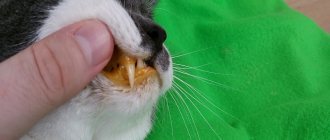Water procedures for animals are not only a necessary component of grooming, but very often also a stress factor. Washing a cat is not at all the same as washing yourself - this is a real test for both the animal and the owner, because a dislike for water is inherent in cats at the genetic level.
But for the professionals at the Bagheera salon, washing even the most fastidious animal will not be a problem . With us, your pet will calmly endure this procedure, remain healthy, become even more beautiful and well-groomed, and you will save your nerves from frustration, and your hands from sharp claws.
When does a cat need a bath?
Many people believe that cats are good at maintaining their personal hygiene on their own because they spend a lot of time licking their fur. It’s really not worth washing your cat every week just to keep its fur smooth and silky. Cat fur is covered with a special lubricant produced by the sebaceous glands. Bathing with shampoo washes away this lubricant, and the natural protection disappears.
Pollution
If the animal is dirty and the contaminated area is large enough, you will have to carry out a bath procedure. Cats love to explore everything around them and can find adventures in their fur - without even leaving the apartment.
Minor dirt can be wiped off with a napkin or a damp cloth - and without washing. Also, do not expose your pet to stress after walks - just wipe his paws if he steps in a puddle.
Before the exhibition
In order for the jury to appreciate your pet, it should be brought into appropriate shape. Usually the cat is taken to a grooming salon, where a specialist does a complete “maraffe”, but some owners cope with this task themselves.
An exhibition animal must be accustomed to complex hygienic procedures from childhood. Otherwise, it will be very difficult to bring it into a decent appearance.
Washing before a show should include cleansing the coat, applying balms, conditioners, oils and powders. Afterwards - thorough combing.
Scheduled cleanliness
The dirt that you bring into the house on your shoes remains in your pet’s undercoat, and by licking it, the cat can harm its body. Therefore, preventive bathing is still necessary.
If your pet is not noticeably dirty, you can wash it no more than several times a year.
Therapeutic bathing (against parasites)
After the cat has been treated for ticks and fleas, it needs to be washed - unless there are contraindications in the instructions included with the drug. Another option is to use insecticidal shampoos. They are a good protection against fleas in cases where the cat accepts bath procedures normally.
Benefits of home treatment
In Moscow, a veterinarian comes to your home around the clock. The function is very convenient for residents of various areas. Sometimes it’s not easy to find transport and get through traffic jams to the desired clinic. Carrying a seriously ill pet can be very dangerous. Choose a veterinarian service at home around the clock when:
- A preventive examination is required.
- Children need to be vaccinated.
- Strange, disturbing symptoms are observed.
- The animal is in severe pain.
- There are open wounds, blood and pus are flowing.
- The pet is lethargic, weak, apathetic, and refuses to eat.
Don't delay calling the clinic! Remember, the sooner a veterinarian arrives at your home, the better for the animal. Many diseases develop rapidly, leaving little chance of salvation if treatment is delayed. Small pets get sick quickly, so don’t hesitate!
Permissible procedure frequency
For almost every cat, bathing is stressful; they do not like water. The thing is that cat fur creates an air cushion over the skin, which provides the kitty with a feeling of comfort and warmth. Therefore, by wetting a cat's fur, you deprive it of its usual comfort.
A healthy cat should be washed no more than once every two months. Excessive bathing with shampoo can only cause harm: dry out the skin and cause irritation. Representatives of long-haired breeds need to be washed a little more often, as their coat requires more careful care.
When not to wash your pet
Sometimes situations arise in which regular washing may be contraindicated for cats. Owners are beginning to wonder how to wash their cat without water and whether it is even possible - fortunately, it is possible.
Contraindications to regular washing include pregnancy (bathing can cause stress in the cat and, as a result, premature birth), the postoperative period, 2-3 weeks after the cat has been vaccinated.
Some illnesses are a contraindication to regular washing; you should consult your veterinarian on this issue. It is better to refuse bath procedures if the cat is constantly itching and has unhealed scabs on its skin.
There are several ways to wash a cat with and without water, without causing stress to the animal. They can be used to clean a dirty pet during pregnancy or illness.
Prices for washing cats and cats
In our pet salon, services are provided both as a package and separately.
Washing a cat costs 500 rubles. But, as a rule, washing is combined with a haircut or combing. Such complexes cost from 1000 to 1400 rubles. Moreover, the cost of washing depends on the condition of the coat and the behavior of the animal.
applying anti-scratch stickers to claws, also called “soft claws,” is very popular in the salon The sticker service costs 150 rubles. or 350 rub. (if we use our own anti-scratch pads).
Prices for our other services
Preparation is an important step
You need to accustom cats to bathing from childhood - about a couple of weeks after you bring your pet home, so that by this time it has already become accustomed to your apartment. When it gets dirty, wipe the cat's fur with a damp cloth so that the cat gets used to the water gradually.
Do not change the place of bathing: if for the first time you washed the cat in a basin, then you do not need to start bathing it in the bathroom: for the animal this procedure should be as familiar and familiar as possible.
What to take to the bathroom
The equipment you will need to wash your cat must be prepared in advance:
- shampoo;
- rubber mat for the bottom of the bathroom;
- a towel – or better yet two;
- hairdryer (if the animal is not very afraid of it).
Remove all tubes and objects that the cat can throw off and get scared even more, sponges and washcloths so that she does not cling to them. Place a rubber mat on the bottom of the bathtub or basin to prevent the cat from slipping.
Choosing a Shampoo
The shampoo should be special, adapted for cat skin, from a veterinary pharmacy - your personal shampoo or soap will not work. A cat will definitely lick itself after bathing, and human shampoos can be toxic to it. In addition, shampoos for people contain dyes and perfumed fragrances, to which allergies can occur.
There is a wide selection of cat bathing products on the market, from budget to expensive. The price depends on the brand, type and purpose (cleansing, medicinal, antiparasitic).
Shampoos come in different forms:
- Liquid
- the most common and familiar, appeared the very first. Liquid shampoos have the best cleaning characteristics. The familiar consistency makes bathing more convenient for the owner.
- Dry
- in the form of mousse or powder, which is sprinkled on the animal’s fur and then thoroughly combed out. Dry shampoo will not clean as well as liquid shampoo, but it is suitable for cats that are categorically against water.
- Shampoo sprays
do not require removal, have antistatic properties, so they are ideal for long-haired cats - after this it is much easier to comb your pet. It sprays quite loudly and can scare the animal - this is a significant disadvantage.
Long-haired cats may need a conditioner - you can buy it along with shampoo at a pet store. Don't skimp on cat cosmetics - it is used little by little, but at the same time it protects the health of your pet.
Where to hold the event
Cats are naturally terrified of water, and the question arises: where can I wash a cat so that it gets less stress and doesn’t scratch its owner? If an animal has unpleasant associations with the bathroom, it is better to move the event to another room. To do this you will need a bowl of water. For those who are less timid, a bath is suitable, but it is better to take it in advance.
You can wet and wash off the foam from the cat using a ladle or jug. It is highly undesirable to use a shower, as it makes noise and scares the animal even more. Another way out is to turn the pressure to minimum.
If you find the right approach and gradually accustom the animal to washing, bathing a cat, even if it is afraid of water, will become as easy as brushing or stroking it.
How to wash a cat
Not every shampoo is suitable for washing our furry pets. And our praised shampoos will not suit them. Suitable detergents have long been invented for our cats and kittens. And they are sold, of course, in a pet store. So before you wash your cat, buy a special shampoo for him. You may also see dry shampoo at the pet store. It is created for cats that absolutely cannot be washed. I can't recommend it because it's less effective. Try to better negotiate with your cat regarding water procedures.
Choose shampoo for your cat at a pet store
How to bathe a cat: step by step procedure
After preparation, you can begin the procedure: ask a loved one to help you. Washing a cat at home is not as difficult as it might seem at first glance.
It is better to trim your pet’s claws a few days in advance to avoid injury. If your cat is afraid of water, fill the bathtub so that half of its paws are submerged. This way the cat will not feel the risk of drowning.
So, the stages of bathing:
- A cat's body temperature is higher than that of a person, so the water should be 35-40 degrees. Place a rubber mat on the bottom of the bathtub: if the cat feels supported, it will be more calm. Take your pet in your arms, bring it to the bathroom and don’t forget to close the door so that it doesn’t run away! Remain calm, because the cat senses your condition.
- Start slowly immersing the cat in the water, gently but firmly hold it by the back so that it does not run away, give it time to get used to it. If it is scratched, start wetting the fur with your hand, not with a shower head, starting from the tail and ending with the withers.
- Have a helper hold the cat's front paws so that her back paws rest against the tub. Be careful not to get water on your head or ears. It will be better if the cat has its back to the exit so that it does not make an escape plan.
- Now you can wash your cat with shampoo. Apply it to the fur with moderately intense movements, starting from the back, going down to the stomach and paws. Don't forget to soap the tail and neck and head at the very end, as animals like this stage the least.
- Move from the base of the hairs to their tips. Do not tangle the fur too much - this will damage its structure, and tangles may subsequently appear.
- You can distribute the shampoo with your hands or with a special silicone brush that you can purchase at a pet store - it will help you cope with this task better. It is better to wipe the face with a damp sponge without using shampoo.
- It's time to rinse off the shampoo. Turn on the water at low power so that it does not make too much noise, and adjust the temperature. If the animal is in severe panic, discard the shower head and use a ladle.
- Start watering the cat from the withers to the tail, using your hand to remove excess foam. Be careful not to let water get into your ears! You need to rinse off the shampoo very thoroughly so that no foam remains.
Hold your cat firmly but gently to avoid injury. Talk to your pet, even if she is screaming a lot at this moment - hearing your voice, she will be calmer. Show maximum love and tenderness, because at the moment the cat is experiencing a lot of stress.
Drying the animal after washing
At the end of the procedure, be sure to dry the animal. Drain the water from the bath and cover the cat with the first towel, lightly blot the fur with it. Do not rub to dry it as quickly as possible - this will tangle the hairs.
Take a clean, large towel and wrap your cat in it, holding him close to you to show you care - you can whisper something soothing in his ear. She may start shaking violently, but after a couple of minutes it will go away and she will calm down.
Try drying the animal with a hairdryer. Have a helper play it in another room so your cat gets used to the sound. Holding it securely in your hands, gradually approach the hair dryer, open its muzzle and direct a warm stream of air at it. If your pet reacts more or less calmly, continue to remove the towel in parts and dry it with a hairdryer. In the future, the cat will understand that the heat source comes from this noisy unit, and will treat it more calmly.
If the cat is frightened by the hair dryer and tries to break free and run away, leave this idea. Release the cat so that it can dry naturally. Make sure that there are no drafts in the room, otherwise your pet may catch a cold - after all, she has become more vulnerable without her air cushion under her fur. Most often, kittens and older cats are susceptible to colds because they do not regulate their body temperature well.
If there are no radiators in the house, turn on the heater for your pet and let her dry near it. After water treatments, the cat will lick its coat for a long time, and there is no need to interfere with it.
How to wash a cat if she is afraid of water
Many cats are terrified of water due to natural features and due to the owner’s incorrect approach to bathing. Since sooner or later you will have to bathe a cat that is afraid of water, you need to learn a few simple tricks. If you follow them, even the most nervous cat will eventually get used to the water and stop throwing “tantrums” while bathing.
The water temperature should be comfortable. For cats this is approximately 35-37 degrees, and for sphinxes - all 40.
It is extremely important to gradually lower the cat into the water. You can start by wetting one paw at a time, while simultaneously holding him so that he cannot move the rest freely.
There should be no sound of water in the room, as some cats are more afraid of it than the water itself. To do this, you need to prepare all the water for washing and turn off the tap.
It is important to calmly talk to your pet during and after the procedure, praise and support it. Animals subtly sense the psychological state of the owner, his tone, care - and they themselves calm down.
At the bottom of the basin or bathtub where the cat will be bathed, it is necessary to place a special rubber mat to prevent the paws from slipping, which can cause panic in the cat.
If the cat strongly resists and it is absolutely impossible to wash it without injury, you need to purchase a special mesh bag for bathing. It will secure the animal’s limbs, preventing it from getting out, scratching and “rowing”, and the structure of the mesh will allow you to easily apply shampoo and rinse off the foam with water.
Another way is to enlist the help of a member of your household. One person will hold the cat, and the second will lather and rinse off the foam. This will make the animal feel more stable in the water and prevent it from scratching you.
The third option is quite unusual, but can also work: take a bath with your pet. Put on a T-shirt and shorts that you don't mind, and go into the water with your cat in your arms. Many pets, seeing that the owner is sitting nearby, calm down and accept the washing procedure much better. In this case, bathing the cat can also be done with an assistant - he will take the clean animal in a towel and help if necessary.
Washing the kitten
Kittens are much easier to wash than adult cats. It is advisable to start washing kittens when they are one year old. But there are situations when you have to start washing earlier. Little kittens love to climb everywhere. They are especially occupied by the windowsill, on which your favorite flowers stand. And having tossed around in the ground to their heart’s content, they, as if nothing had happened, with dirty paws, come to your bed. Your task is not only to wash the kitten, but also to try to accustom it to water. Don't scold him, let him remain in a playful mood. After filling the basin or bathtub with water, close the water. Place one or more of your kitten's favorite toys in the water. And then quietly lower the kitten into the water. Consider yourself very lucky if the kitten does not get scared, but on the contrary, starts playing in the water. Don't bother him, let him play a little. And after some time, start washing your mischief-maker.
Try to accustom your kitten to water











